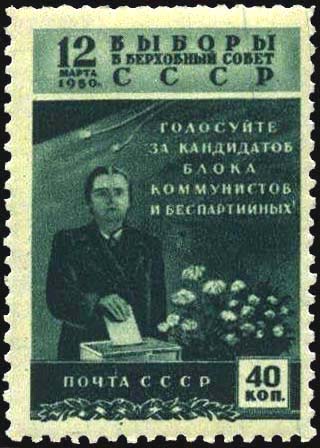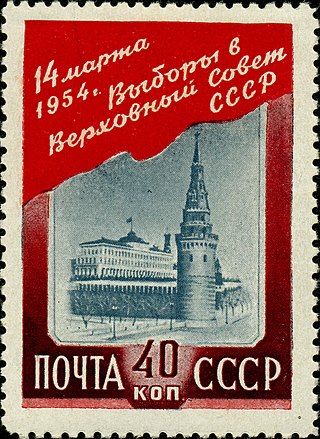
The political system of the Soviet Union took place in a federal single-party soviet socialist republic framework which was characterized by the superior role of the Communist Party of the Soviet Union (CPSU), the only party permitted by the Constitution.

Demokratizatsiya was a slogan introduced by Soviet Communist Party General Secretary Mikhail Gorbachev in January 1987 calling for the infusion of "democratic" elements into the Soviet Union's single-party government. Gorbachev's Demokratizatsiya meant the introduction of multi-candidate—though not multiparty—elections for local Communist Party (CPSU) officials and Soviets. In this way, he hoped to rejuvenate the party with progressive personnel who would carry out his institutional and policy reforms. The CPSU would retain sole custody of the ballot box.

Presidential elections were held in the Russian Soviet Federative Socialist Republic (RSFSR) on 12 June 1991. This was the first Russian presidential election in the country's history. The election was held roughly three months after Russians voted in favor of establishing a presidency and holding direct elections in a referendum held in March that year. The result was a victory for Boris Yeltsin, who received 58.6% of the vote.

Parliamentary elections were held in Russia on 12 December 1993. They were the first parliamentary elections in post-Soviet Russia and the only time to the Federation Council, with future members appointed by provincial legislatures and governors.
Supreme Soviet elections were held in the Lithuanian SSR on 24 February with run-off elections on 4, 7, 8 and 10 March 1990 to elect the 141 members of the Supreme Soviet. In six constituencies, voter turnout was below the required minimum and a third round was held on 17 and 21 April. For the first time since 1940 elections to the People's Seimas, non-communist candidates were allowed to run. The elections were the first free nationwide elections since 1926, and only the fifth free elections in all of Lithuanian history.

The electoral system of the Soviet Union was varying over time, being based upon Chapter XIII of the provisional Fundamental Law of 1922, articles 9 and 10 of the 1924 Constitution and Chapter XI of the 1936 Constitution, with the electoral laws enacted in conformity with those. The Constitution and laws applied to elections in all Soviets, from the Supreme Soviet of the Soviet Union, the Union republics and autonomous republics, through to regions, districts and towns. Voting was claimed to be secret and direct with universal suffrage. However, in practice, before 1989, voters could vote against candidates preselected by the Communist Party only by spoiling their ballots, whereas votes for the party candidates could be cast simply by submitting a blank ballot.

In 1989, elections were held for the Congress of People's Deputies of the Soviet Union. The main elections were held on 26 March and a second round on 9 April. They were the first partially free nationwide elections held in the Soviet Union, and would prove to be the final national elections held as the country dissolved in 1991. The elections were followed by regional elections in 1990, the last legislative elections to take place in the country.
Elections to the Supreme Soviet were held in the Soviet Union on 14 June 1970.
Elections to the seventh Supreme Soviet were held in the Soviet Union on 12 June 1966.

Elections to the Supreme Soviet were held in the Soviet Union on 12 March 1950.

Elections to the Supreme Soviet were held in the Soviet Union on 14 March 1954.
Elections to the Supreme Soviet were held in the Soviet Union on 16 March 1958.

The Congress of People's Deputies of the Soviet Union was the highest body of state authority of the Soviet Union from 1989 to 1991.
Elections to the Supreme Soviet were held in the Soviet Union on 18 March 1962.
Elections to the Supreme Soviet were held in the Soviet Union on 16 June 1974.
Elections to the Supreme Soviet were held in the Soviet Union on 4 March 1979. They were the first elections held under the 1977 Soviet constitution, which slightly reformed the composition of the Supreme Soviet.
Parliamentary elections were held in Romania on 3 February 1957. Voters were presented with a single slate of candidates from the People's Democratic Front (FDP), which was dominated by the Romanian Workers Party (PMR). The Front won all 437 seats in the Great National Assembly.
Parliamentary elections were held in Romania on 5 March 1961. Voters were presented with a single list from the People's Democratic Front (FDP), which was dominated by the Romanian Workers Party (PMR). The Front won all 465 seats in the Great National Assembly.
Parliamentary elections were held in Romania on 7 March 1965. Voters were presented with a single list from the People's Democratic Front (FDP), which was dominated by the Romanian Workers Party (PMR). The Front won 465 seats in the Great National Assembly.
Parliamentary elections were held in Romania on 9 March 1980. The Front of Socialist Unity and Democracy, dominated by the Romanian Communist Party and including other mass organisations, was the only organisation that contested the election. No prospective candidate could run for office without the Front's approval. The Front won all 369 seats in the Great National Assembly.








